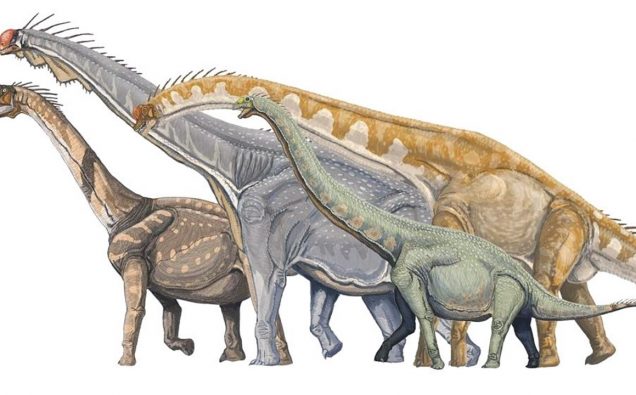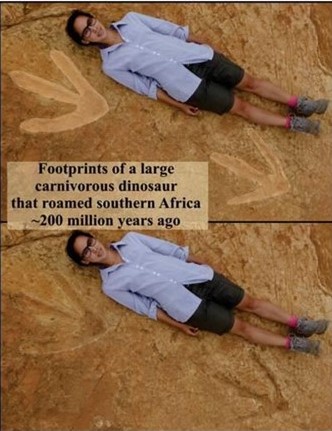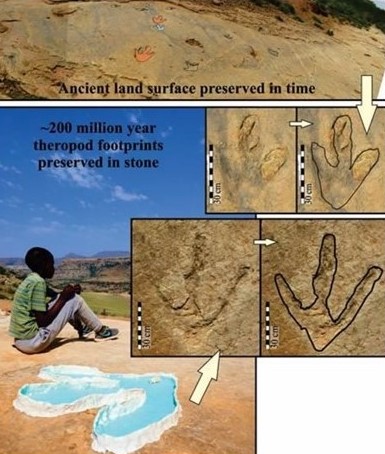
Photo: Artists’ impression of four macronaria, Credit :Богданов dmitrchel@mail.ru [GFDL (http://www.gnu.org)/Wikimedia Commons
Researchers in South Africa have found massive footprints of dinosaurs suggesting that much larger creatures would have roamed the planet – stirring excitement in the international scientist community as well as fuelng the sci fi imagination.
The discovery of the evidence on the existence of “extremely large” predatory carnivorous (meat-eating) dinosaur dating back to 200 million years ago in what is southern Africa is the result of work by scientists from the University of Cape Town, South Africa University of Manchester, UK, and Universidade de São Paulo, Brazil.

UCT PhD student Miengah Abrahams lies next to the megatheropod tracks found in
western Lesotho. Abrahams is 1.6 m tall. Photo: UCT
Their new study, published in PLOS One, sketches out the picture of a very large, three-toed, 57 cm long and 50 cm wide footprints of these huge animals, informally called “megatheropods,” according to the University of Capetown.
“With an estimated body length of about 9 meters and hip height of 2.7 meters, this animal would have roamed a landscape otherwise dominated by much smaller carnivorous dinosaurs and a variety of herbivorous and omnivorous dinosaurs,” the UCT said this week.

Photograph showing an overview of the Lesotho palaeosurface which contains the
footprints of theropod dinosaurs and the 57 cm long megatheropod footprints. Inserts are of
typical theropod footprints on the ancient surface in comparison to the megatheropod tracks.
The Basotho boy is sitting next to a megatheropod footprint which was being cast in blue
silicon rubber. Photos: UCT
It was during a trip in the Roma Valley near the National University of Lesotho that researchers discovered the footprints last year after which scientists worked to assess the date of the fossil footprint.
According to the UCT, the discovery marks the largest theropod trackways ever found in Africa for this time period. Holy Cross Mountains, Poland is the only other site bearing similar aged tracks but of a marginally larger size.
The meat-eating dinosaur is bigger than Steven Spielberg’s Jurassic Park animals thar run amock the place, terrifying humans trying to escape.
The University’s postdoctoral fellow Lara Sciscio, who is the lead author of the publication and part of the discovery team, says these “new
giant megatheropod tracks have been assigned a new species name (ambrokholohali).”
This name was, in part, derived in honour of Emeritus Professor David Ambrose for his detailed recording of the trace fossil heritage within the Roma Valley, Lesotho, she explains according to the University’s department of communication.
“In trying to relocate one of Prof Ambrose’s sites, we discovered the newly exposed megatheropod tracks reported in the article.”
The UCT explains that Theropod dinosaurs, such as Allosaurus and iconic Tyrannosaurus, were some of the main bipedal predators during the Mesozoic Era, the ‘Age of Dinosaurs’.
During the Early Jurassic, the size of theropod dinosaurs was usually small (less than 3–5 m body length). It is only much later in time (about 120 million years or so), within the Late Jurassic and Early to Middle Cretaceous, that truly large forms of theropods start making their appearance in the body and trace fossil record, it says.
“This makes the new discovery of these impressively large tracks more scientifically impactful.”
















